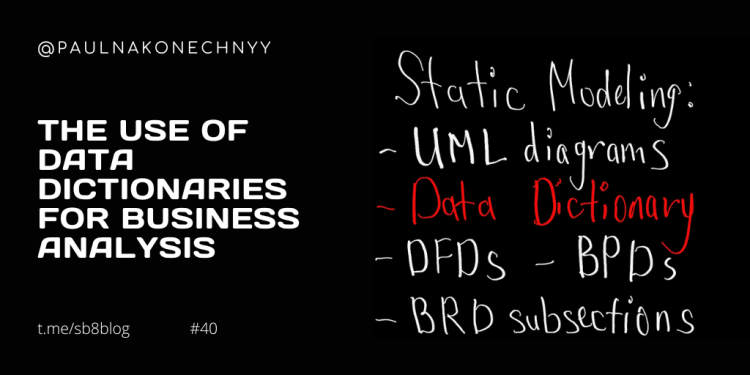The Use of Data Dictionaries for Business Analysis
Published by Pavel Nakonechnyy on in Business Analysis.
What Is a Data Dictionary?
Data Dictionary – a collection of names, definitions, and attributes about data elements that are being used or captured in a database, information system, or part of a research project. A data dictionary is used to catalog and communicate the structure and content of data and provides meaningful descriptions for individually named data objects.
Usually, maintenance of Data Dictionaries is included in Data Quality processes and measures of the company.
Why Use a Data Dictionary?
Data Dictionaries:
- Assist in avoiding data inconsistencies
- Help define conventions that are to be used across a project
- Provide consistency in the collection and use of data across multiple systems and teams
- Make data easier to analyze
- Enforce the use of Data Standards
What Are Data Standards and Why Should I Use Them?
Data Standards are rules that govern the way data are collected, recorded, and represented. Standards provide a commonly understood reference for the interpretation and use of data sets.
By using standards, data users will know that the way their data are being collected and described will be the same across different projects and systems. Using Data Standards as part of a well-crafted Data Dictionary can help increase the usability of your data, and will ensure that data will be recognizable and usable beyond the immediate use.
Data Dictionary for Business Analysis
Data Dictionary is one of the documents used for static modeling to define Business Concepts, Objects, and Rules. Other tools BAs employ are UML diagrams, DFDs, BPDs, flowcharts, and BRD subsections. The static model defines and documents rules related to business concepts and business object types, such as:
- People and organizations
- Transactions and events
- Products and services
- Locations
Data Dictionary documents business objects as they will be created in the future DB. It includes definitions, attributes, examples, subtypes, volumes, and cardinalities (links between objects).
Making a Data Dictionary
Most database management systems (DBMS) have built-in, active data dictionaries and can generate documentation as needed (SQL Server, Oracle, MySQL). The same is true when designing data systems using CASE tools (Computer-aided software engineering). Finally, you can create the Data Dictionary manually using Excel Template.
Often organizations or regulators impose requirements for data metadata records, such as who produced the data and why, collection and processing methods, definitions of entities and attributes, geographic location, and any access or use constraints, all of which facilitate the evaluation of the data and information for use.
Data Dictionary and Data Quality
For both data producers and consumers, the Data Dictionary can reveal potential credibility problems within the data. Poor table organization and object naming can severely limit data understandability and ease of use, incomplete data definitions can render otherwise stellar data virtually useless, and failure to keep the dictionary up to date with the actual data structures suggests a lack of data stewardship. Although getting critical feedback about their data may be initially troublesome for some data creators, developing good data design and description habits is worth the effort and ultimately benefits everyone who will use the data.